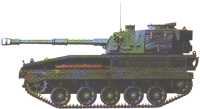The Gun - Mechanisation continuedSelf-Propelled Field and Medium GunsThe invention of the tank by the British in 1915 gave birth to many ideas fir its use as a mobile platform for field, medium, and even heavy guns. Early efforts in Britain in this direction were makeshift, eg the loading of a 60-pr on to a tank chassis to transport it to a gun area then the unloading of it to bring it into action. Similar attempts by other nations were made during the last stages of World War 1 and the early 1920s. France produced some promising prototypes. Indeed the French Inspector General of the Artillery correctly foresaw the need for SP guns in the future but unfortunately at the time received no support from his colleagues. When in 1936 they admitted he was right and decided to act it was too late; World War 2 broke out before any useful equipments resulted. In 1925 Britain produced the first true fully-tracked SP gun by taking a standard Vickers medium tank chassis and mounting upon it an 18-pr Mark 5 gun. There were two versions: one operated as a straight field gun, while a later (1926) model which could elevate to 85° functioned in both field and AA roles. Known as the 'Birch Gun' after General Sir Noel Birch, Master General of the Ordnance, who was responsible for its introduction, it was intended to be a model for the supporting artillery of an experimental armoured force but was short-lived. Although the gun passed its trials satisfactorily a number of senior Officers were prejudiced against it; one even called it a 'monstrosity'. They argued about it: was it a gun or was it a tank? Should it be manned by Gunners or should it be manned by Troopers? Interest waned. Money for development was not forthcoming, so around 1930 the whole scheme was abandoned - and the equipments scrapped. Thus when World War 2 soon demonstrated the need for an SP field gun the British found themselves no better off than the French. | |
|
If field guns were to support tanks they had to have the same cross-country capabilities, ie had to be mounted upon tacked vehicles. Once again Gunners were saddled with makeshifts. Late in 1941 the first appeared; it was the Bishop, a 25-pr gun in a large steel box sitting on a Valentine tank chassis. It did not impress; due to the construction of the box the gun could elevate no more than 15° which restricted range to 6400 yds (5850 metres) instead of the normal 13400 (12225). |
 Bishop |
 Priest |
In November 1941 the Americans produced the Priest , their standard 105-mm field piece mounted upon a modified Grant M3 tank chassis. Some say the resemblance of its machine gun cupola to a church pulpit gave rise to the ecclesiastical nickname, thus continuing the tradition begun with the Bishop. Being rather better engineered, it proved a very successful equipment, having been used by the British as well as the Americans in all theatres of World War 2. |
|
Britain wanted the Americans to build a 25-pr version of the Priest but they could not see their way clear to produce an equipment they would not use themselves. However, the Canadians set up a factory to make the Ram tank, a local pattern version of the Grant M3 which proved suitable for mounting the 25-pr. This combination became the Sexton which saw service until the 1950s. The first British gun to be designed as an SP equipment from its inception is the Abbot carrying a 105-mm piece with a range of 17000m. It entered service in 1964 but is now obsolete. | |
 |
 |
| Sexton Length: 6.1m Calibre: 25-pr howitzer, two 7.69mm Bren Guns, 12.7mm Browning machine gun |
Abbot Length: 5.84m Calibre: 105mm gun, 7.62 anti-aircraft machine gun, three smoke dischargers |
|
The AS90 (Artillery System 1990) 155-mm SP gun replaces both the Abbot and the M109, an American 155-mm howitzer previously in service in the British Army. The AS90 is undergoing troop trials this year (1994) after which it will be issued to all RHA regiments. Other SP equipments in use in Britain since World War 2 include the US M107 (175-mm), the M110 (203-mm), all of which are obsolescent. | |
 |
 |
| M109 Length: 6.6m Calibre: 155mm howitzer, 12.7mm anti-aircraft machine gun |
AS90 Length: 7.2m Calibre: 155mm howitzer |
|
The AS90 represents an entirely new concept in the tactical employment of artillery in war, including nuclear war, beyond the scope of this paper to describe. It can operate entirely on its own, ie without a command post to calculate gun data, or a troop leader to lead it into action. The AS90 has no dial sight! As it has its own means of obtaining accurate orientation it needs no director to put it at the centre of arc (zero line to World War 2 Gunners). It is equipped with an inertial navigation system (INLS), so that having been given the grid reference of his gun position the Number 1 goes to it without further assistance. The gun can come into action within 1½ minutes and be out of action in less than one. It carries 48 rounds of ammunition and can fire a burst of three rounds in ten seconds. A battery can put over a tonne of shell on a target in the same time to a range of 24700 metres. WL Ruffell, December 1993 previous | index | next | History index | Home | |